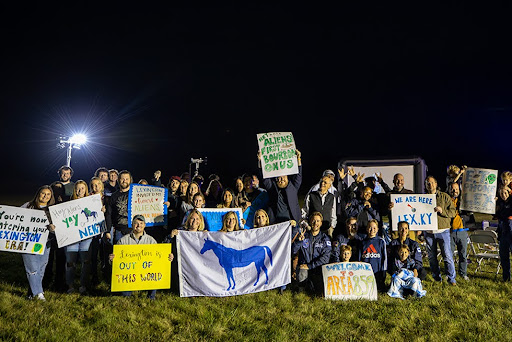Hello! We are happy to receive you!
In January 2024, a team of local scientists and scholars sent a similar message into space in the hopes of promoting some interstellar tourism. The team, sponsored by VisitLEX, the Lexington Convention and Visitors Bureau, used a coded bitmap image to advertise Lexington and all its qualities to audiences lightyears away. The concept itself is still relatively new, although rapidly developing technologies are allowing many different groups to take advantage of this marketing strategy. The idea is novel, if a bit flawed. This campaign is akin to throwing out the proverbial message in a bottle; although VisitLEX’s message’s destination is the nearest habitable solar system, it will still take 40 years for the message to reach it and another 40 for us to receive a response.
However, those involved have full faith in their little message, which spared no detail in its promotion of our city. Those at VisitLEX have said they believe Lexington is the best place on Earth, and their message certainly aims to prove that. The bitmap image showcases all the best parts of Lexington, from its depiction of the rolling hills of bluegrass, to audio recordings of local musicians, and a molecular breakdown of water and bourbon. As the image’s depiction of the dopamine molecule suggests, whether our extraterrestrial friends are here to visit or stay, they’re sure to have a good time.
And as we begin the long wait to hear back from them, VisitLEX’s campaign has been busy convincing those on Earth to come visit, as well. Aside from the bitmap message, their advertisement also consists of a website that some have been calling “the extraterrestrial’s guide to Lexington.” VisitLEX’s website, which comically explains Lexington’s signature products like an alien might (for example, calling thoroughbreds “four-legged superstars”), has already surpassed millions of views, and website traffic has increased to nearly double what it was in 2023. Many news outlets nationwide have also taken notice of this campaign, bringing even more attention to both it and Lexington itself. While it’s uncertain just how many people have visited Lexington because of VisitLEX’s attempts at interstellar tourism, it’s clear that the company’s efforts have not been in vain. No matter what happens to their message in a bottle, VisitLEX can rest assured that the conversation surrounding that message will more than makeup for any losses.
Even so, it’s nearly impossible to tell whether VisitLEX’s attempts at interstellar tourism will yield any long-term scientific rewards. In the face of the long journey their message will make, any predictions seem pointless. However, this field of communication is still new, and it’s not unlikely that we’ll see similar efforts as technology continues to improve. Who knows? Maybe one day we’ll be on the receiving end of an invitation.
But for now, we’ll keep sending our messages up into the sky, finding excuses to share our love and pride in our communities with someone else.



